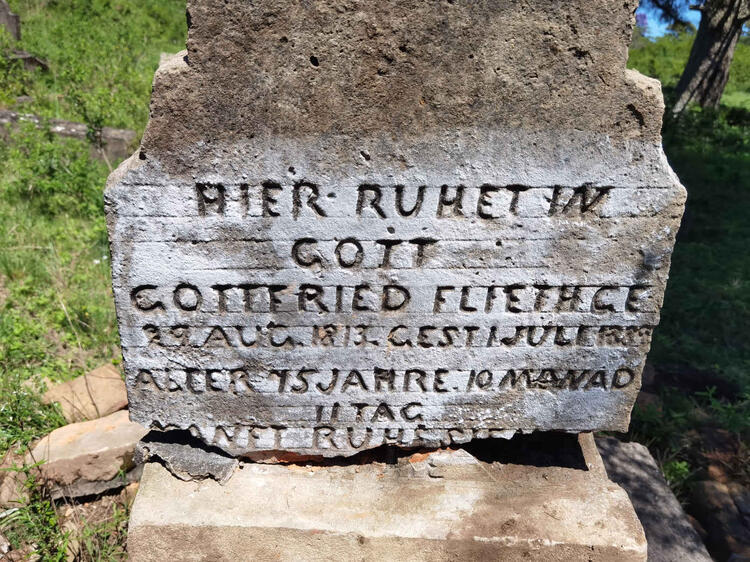**denotes a direct ancestor of Sally-Ann Barker Clur in this text.
**Gottfried Flieth, father of my great, great, grandmother **Louise Wilhelmine Clur nee Fleith, was born on the 29th August 1813 in Meichow, Uckermark, Prussia, Germany. He was the son of **Elizabet Flieth born Desmarets and **Johann Flieth (1777 – 1865). Gottfried’s death certificate says he was born on the 5th September 1813 (see further on below), however, that appears to be the day of his baptism. Gottfried had at least 4 siblings, possibly including :
- Daniel Flieth ?
- Michael Flieth ( 1812 – ?)
- Elizabeth Flieth (c1813 – ?)
- one who died young – ?Johann Friedrich Flieth (1768-1776).
- Possible half siblings:
- Johann Flieth (c1815 – ?), who married Wilhelmine Meissner on the 4th June 1837
- Luise Flieth (c1817 – ?), who married Wilhelm Schwarz on the 4th August 1839
- Elizabeth Flieth (c1821 – ?), who married Martin Krüger in 1842
- Christine Flieth (c1828 – ?), who married Wilhelm Friedrich Mercier on the 4th November 1855
**Elizabet Desmarets and **Johann Flieth (1777 – 1865), married on the 14th November 1809. Johann Flieth’s death certificate states that he was a labourer of Meichow and that when he died he left his wife “Louise Desmarets” and possibly five major and five minor children behind – (that part of the death notice I can not decipher completely, but I seem to see the name of a child – Johann Flieth). Johann married Louise Desmarets (3rd March 1792 – ?) on the 31st May 1814, the sister of Elizabet, who had presumably died. Johann died of old age – being 87 years, 10 months and 17 days old when he died- at 2 o’çlock on the 6th September 1865. He was buried on the 8th September in the Meichow graveyard. It is very difficult to read the name of Johann Flieth’s father on his marriage certificate. He may have been Johann Flieth (c1728 – 1810) from Zichow. His mother on the marriage notice is recorded as **Maria Blond from Meichow. However, there is documentation that Johann Flieth (c1728 – 1810) married Marie Schoenemann. She was 63 when she died on the 26th December 1810 in Zichow, making her birth year c1747. The Grundmann Web Site managed by Udo Grundmann on My heritage, lists a Johann Flieth (1741-1824) of Zichow as the father of Johann Flieth (1777-1865).

The name of Johann Flieth’s (1777 – 1865) father as written on his marriage certificate – can you decipher it? (Gottfried/ Johann??)


Elizabet Desmarets, Gottfried’s mother, was the second daughter of **Jacob Desmarets (treasurer), (16th March 1752 – 10th May 1821) and **Rachel Betac, (? 16th September 1759 – 6th April 1843). Rachel was a widow when she married Jacob and was married to Jaques (Jacob) Devantier on the 14 January 1780. On that marriage record Rachel is described as the daughter of **Jacob Betac (7th September 1710 – 10th March 1779) and **Elizabeth Vieillard (4th October 1716- 19th April 1793). Jacob Desmarets and Rachel were married on the 12th September 1783 in Gramzow. Jacob was a widower, he had previously married Anne Schroeder on the 1st November 1781. Anne died on the 6th March 1783, only 7 months before Jacob married Rachel.
Rachel Betac‘s parents, however, according to her baptism record of 23rd September 1761, were Michée Betac (1740 – 1809) and Marie Berthe. Marie Catharina Berthe’s parents were Michel Berthe (24th June 1695 – 23rd March 1748) and Judith Devantier (1701 – 16th March 1748). Rachel was born in Fredersdorf in Uckermark, Brandenburg, Germany. Interestingly, her baptism notice mentions that she was christened in the Temple of Gramzow. This Temple is now a ruin of the former monastery church dating back to at least 1168. It burnt down in 1714, several years before Rachel was born – so one wonders then if there was an open-air ceremony in the ruin, or if there was another church referred to as the Temple? Her Godparents are listed as Abraham Berthe a ploughman from Briest (and brother of her mother), and her godmother as Rachel Desmarets, wife of Jacob Gindat? a ploughman from Fredersdorf. Going further back, I am led to believe that Michée Betac’s parents were also **Jacques (Jacob) Betac and **Elizabeth Veillard who were married in Prenzlau in 1731. This suggests then that the Rachel Betac of the 23rd September 1761 was not the wife of Jacob Desmarets, but rather the niece of his wife Rachel Devantier nee Betac.
Elizabeth Veillard’s parents were **Isaac Vieillard (1693 – ?1759) and **Jeanne Gervais (?1693 – ?1717). Isaac Vieillard’s parents were **Issac Vieillard (1667 – 1699) and **Magdelaine Rossingnol (1670 – ?1713). Magdelaine’s parents were **Marie Sarrasme and **Pierre Rossingnol. Furthermore, Jacob Desmarets‘ (1752 – 1821) parents were **Jacob Desmarets (22nd March 1725 – 22nd February 1772 ) and **Susanne Mercier (1730 – 1761-7), who got married on the 22nd October 1750 in Meichow. There is also a record of a Jacob Desmarets, son of Timotheus Desmarets and Susanna who was baptised on the 24th May 1699, who could be Jacob Desmarets’ (1725 – 1772) father. This means that this line of direct relatives has been traced back though 11 , possibly 12, generations.
Gottfried Flieth was descended from Huguenot immigrants who arrived in Brandenburg – Prussia towards the end of 1600. Huguenots were French Protestant refugees who left France under Louis XIV, mainly after about 1680 for reasons of religious persecution. (Walloons from French speaking Flanders, the Dutch from the Netherlands in the 16th century and also earlier waves of French people fleeing from France, especially the Massacre of Saint Bartholomew of 1572 are also included in de definition of Huguenots.) The Huguenots were often skilled traders and entrepreneurs, and thus served to make Brandenburg prosperous and rich after the devastation that followed the Thirty Years’ War.
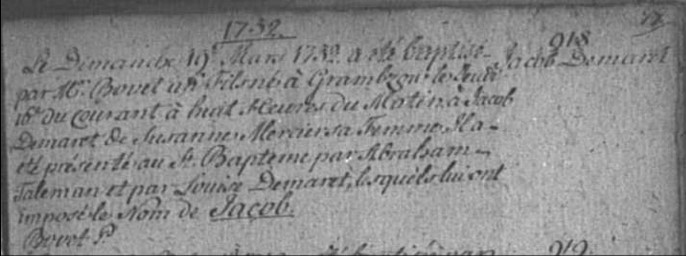
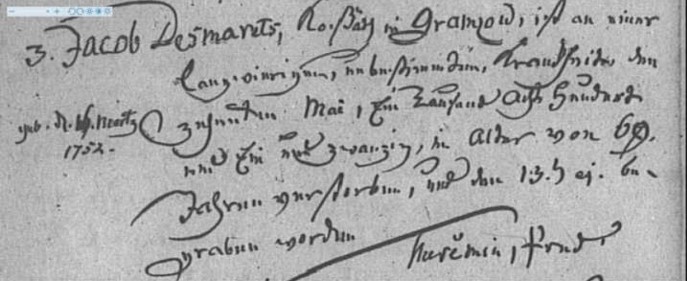
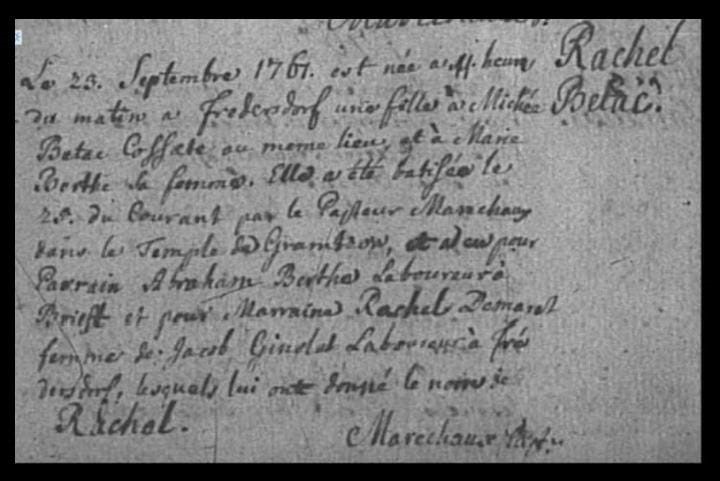

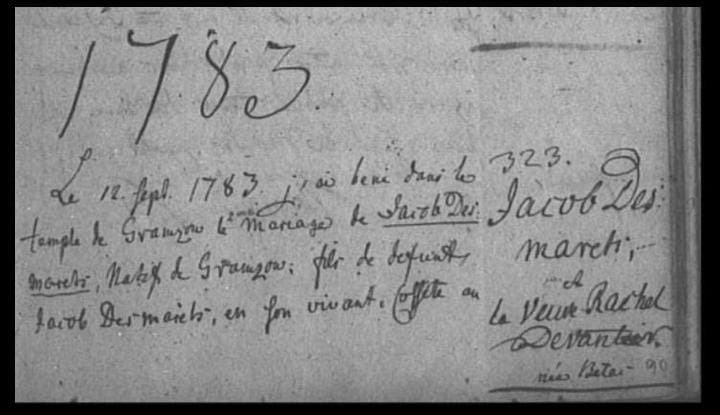


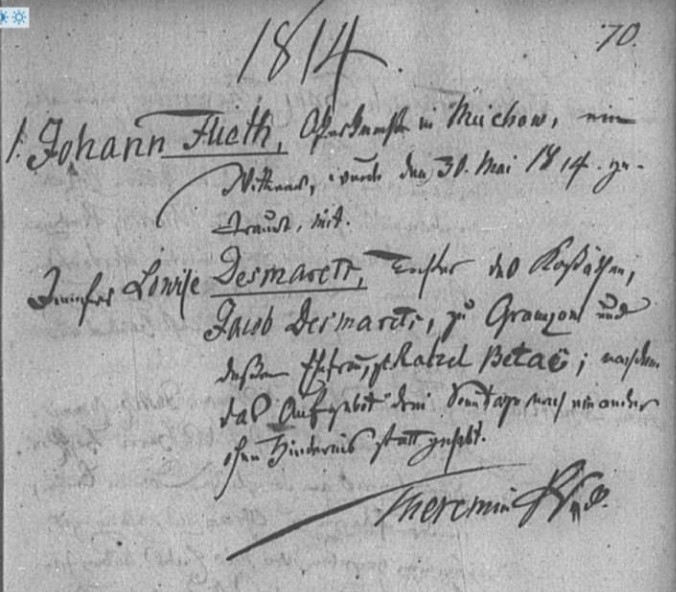

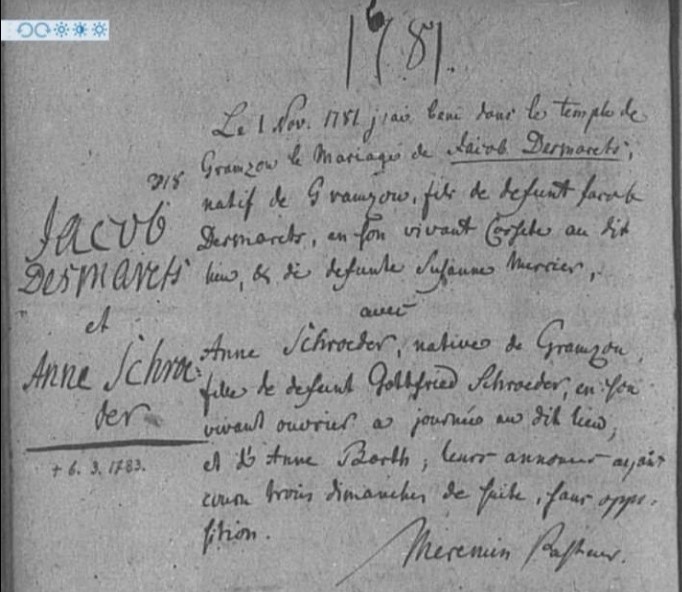
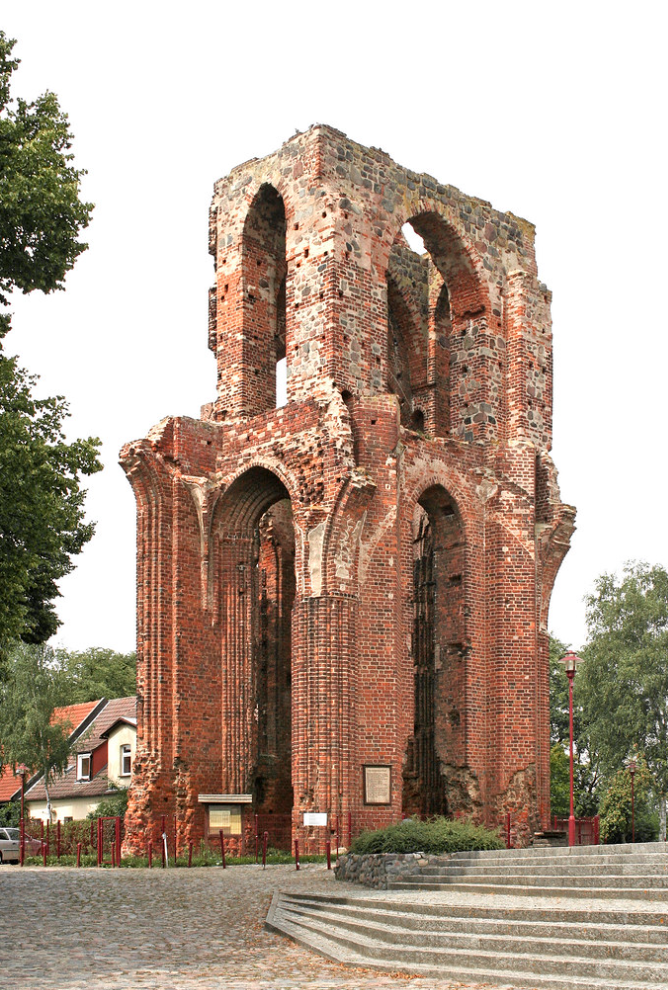
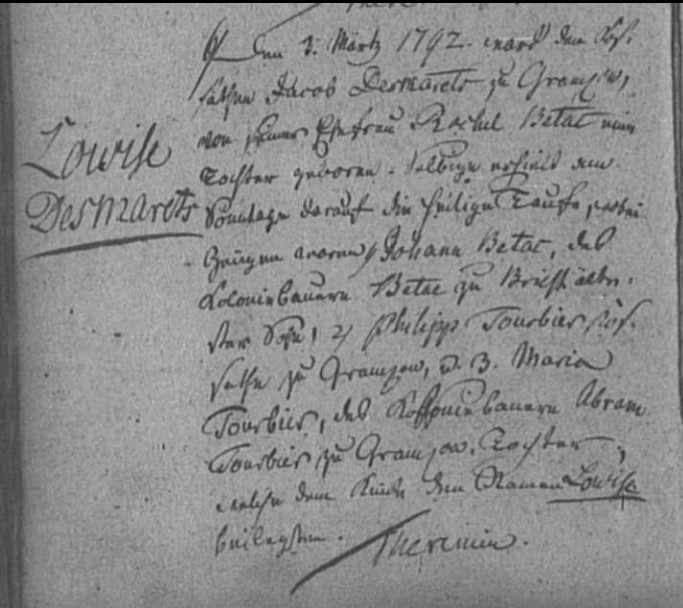
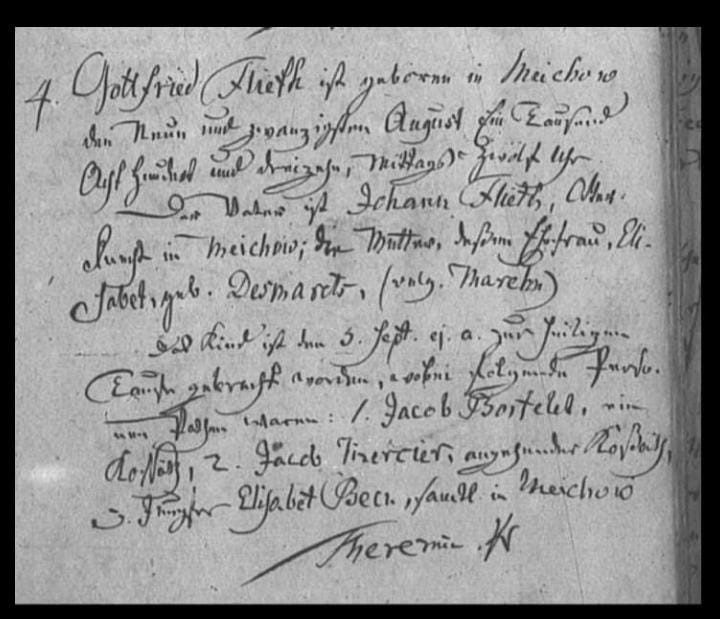
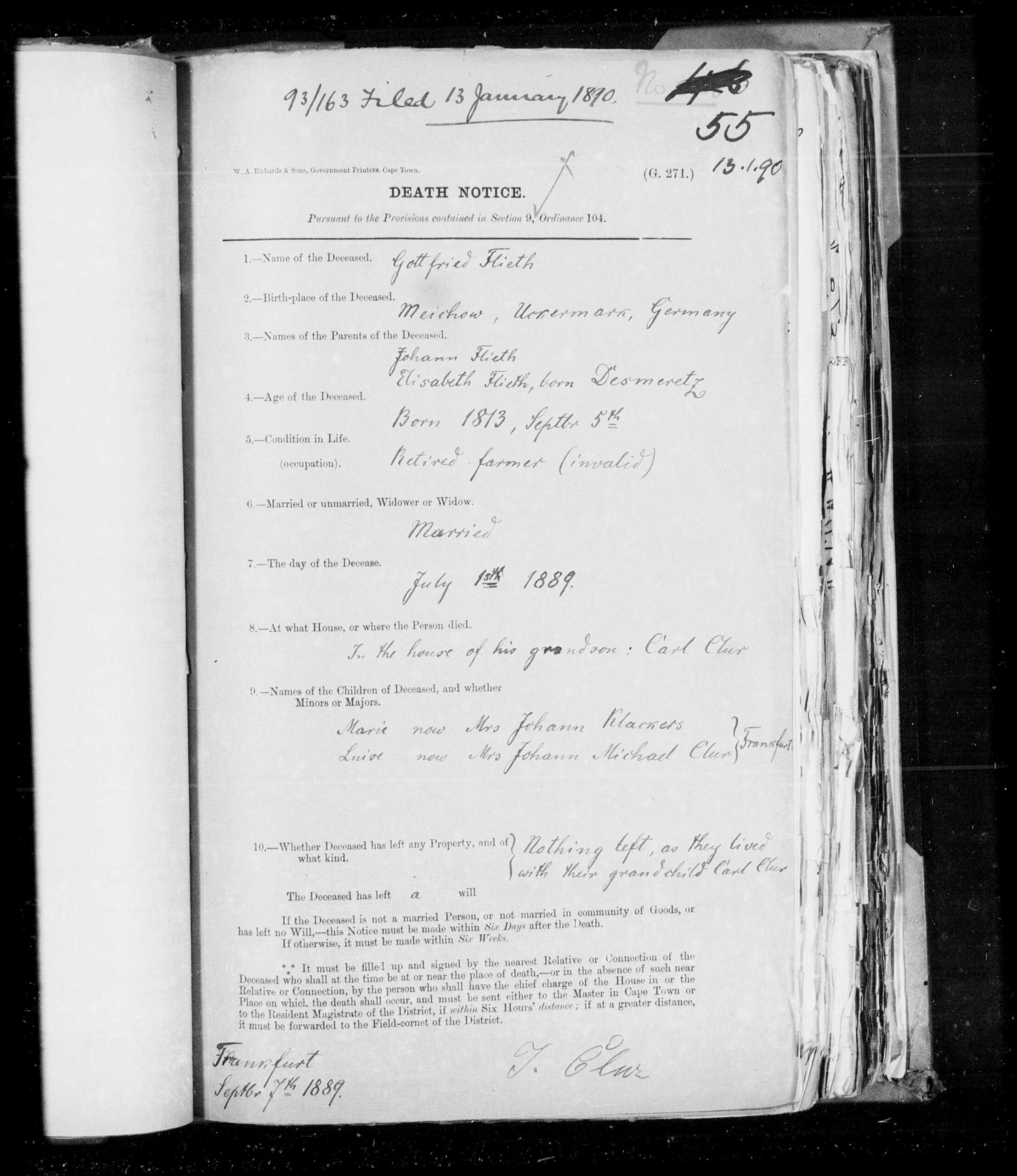
- Sources
- Jacob Desmarets (1752–1821), Rachel Bettac (1759–1843) • Landscape View • Family Tree • FamilySearch
- Germany, Prussia, Brandenburg and Posen, Church Book Duplicates, 1794-1874:
- Johann Flieth Country: Germany; State: Brandenburg; County: Angermünde; Township: Gramzow; Folder: 4110882; Film: 1334996; Image: 313
- volume 126, GS: Film number 1273006, Digital Folder number 004109915, Image number 00354,
- volumes 124, 125, GS Film number 1273006, Digital Folder number 004109915, Image number 00169
- volume 107, 1082, GS Film number 1273002, Digital Folder number 004109911, Image number 00543
- https://www.myheritage.com/research/record-30054-719875/rahel-betac-desmarets-in-germany-prussia-brandenburg-posen-church-book-duplicates Rahel Betac Desmarets Country: Germany; State: Brandenburg; County: Angermünde; Township: Potzlow; Folder: 4109915; Film: 1273006; Image: 390
- FamilySearch (https://www.familysearch.org/ark:/61903/1:1:V4LF-65l, Entry for Jacob Desmarets, 1699.
- FamilySearch (https://www.familysearch.org/ark:/61903/1:1:J481-TPT, Entry for Gottfried Flieth and Johann Flieth, 1839.
- “South Africa, Cape Province, Probate Records of the Master of the High Court, 1834-1989”, ,FamilySearch (https://www.familysearch.org/ark:/61903/1:1:QPHD-JPSW, Entry for Gottfried Flieth, from 1889 to 1890.
- FamilySearch (https://www.familysearch.org/ark:/61903/1:1:J4DH-P8J, Entry for Gottfried Flieth and Gottfried Flieth, von 1832 bis 1874.
- FamilySearch (https://www.familysearch.org/ark:/61903/1:1:J4DH-TXK, Entry for Wilhelmine Ernestine Flieth and Gottfried Flieth, von 1832 bis 1874.
- http://www.eastlondon-labyrinth.com/germans/ship-wilhelmsburg.jsp).
- Tracing Huguenot ancestors | The National Archives
- Documents from Marilù Fiorillo
When 26 years old (in 1839) Gottfried Flieth married **Henriette Louise Spann (21 years old, thus born circa 1818, although another reference notes that she was 25 making her birth year 1814, on the ship’s passenger list for her journey to South Africa in 1958 she is recorded as being 44, confirming 1814 as her year of birth), on the 3rd November 1839 in Potzlow Gramzow, Angermünde, Brandenburg, Germany. Indeed her tombstone records her birth as 28th January 1814 and her death as 13th April 1898 (see further below). Gottfried’s father is given as **Johann Flieth, labourer from Meichow, and Louise’s father as **Christ. (Christian) Spann (labourer).
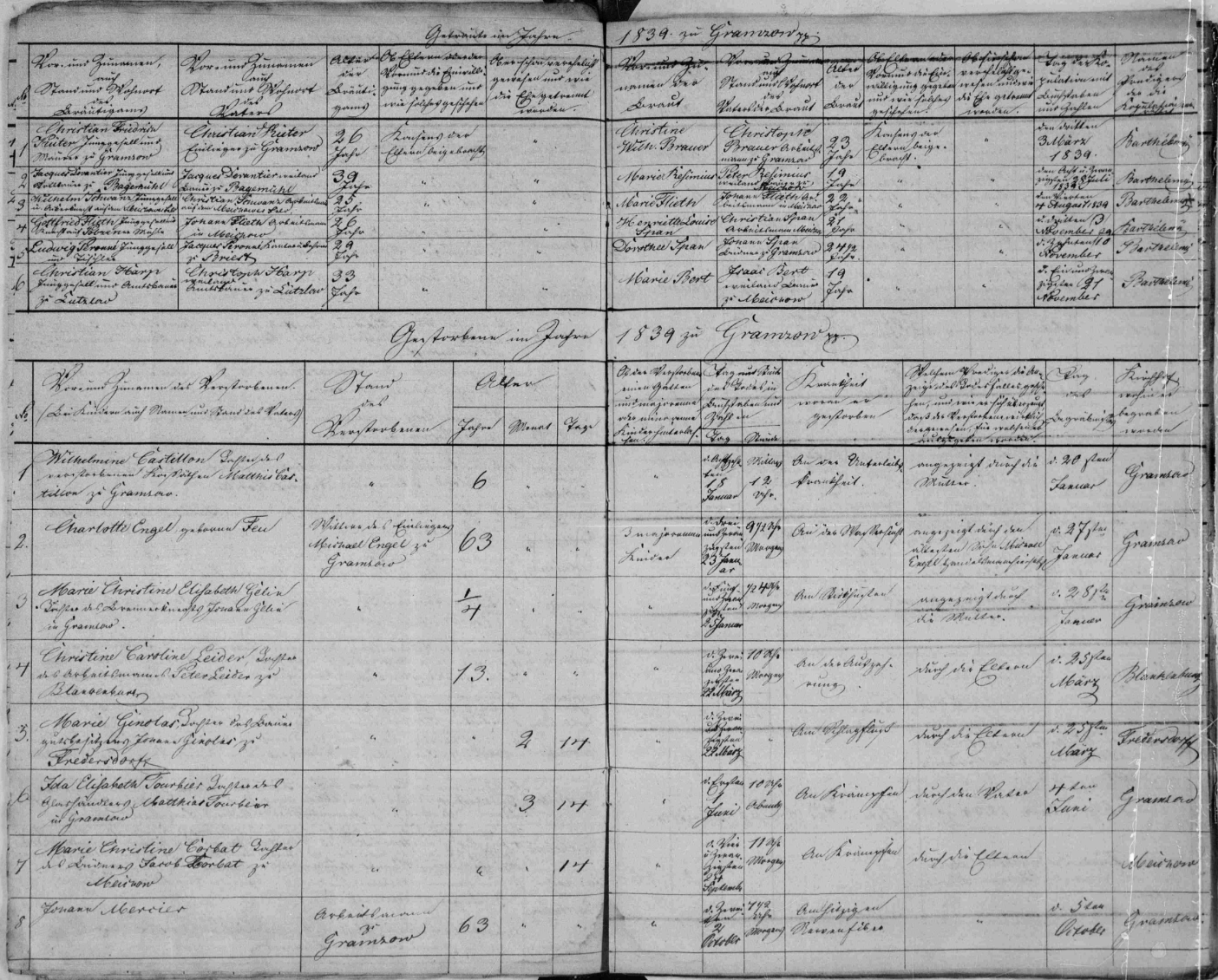
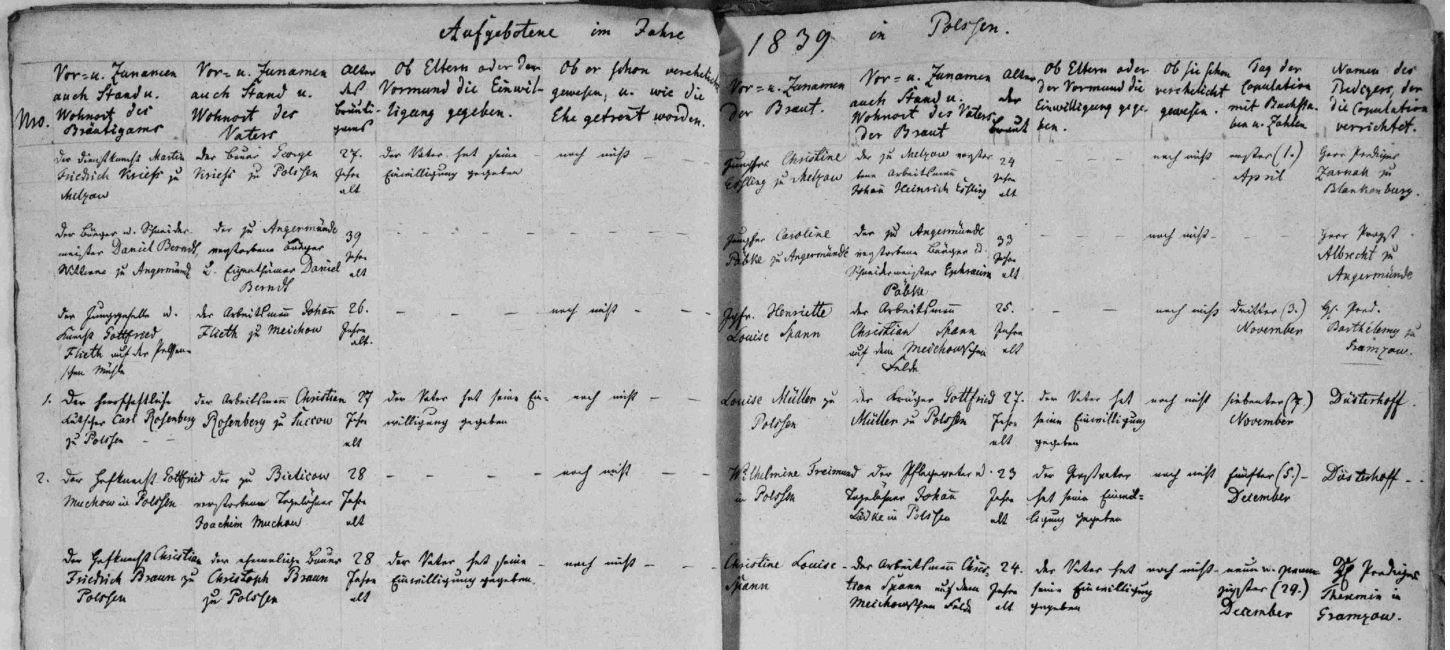
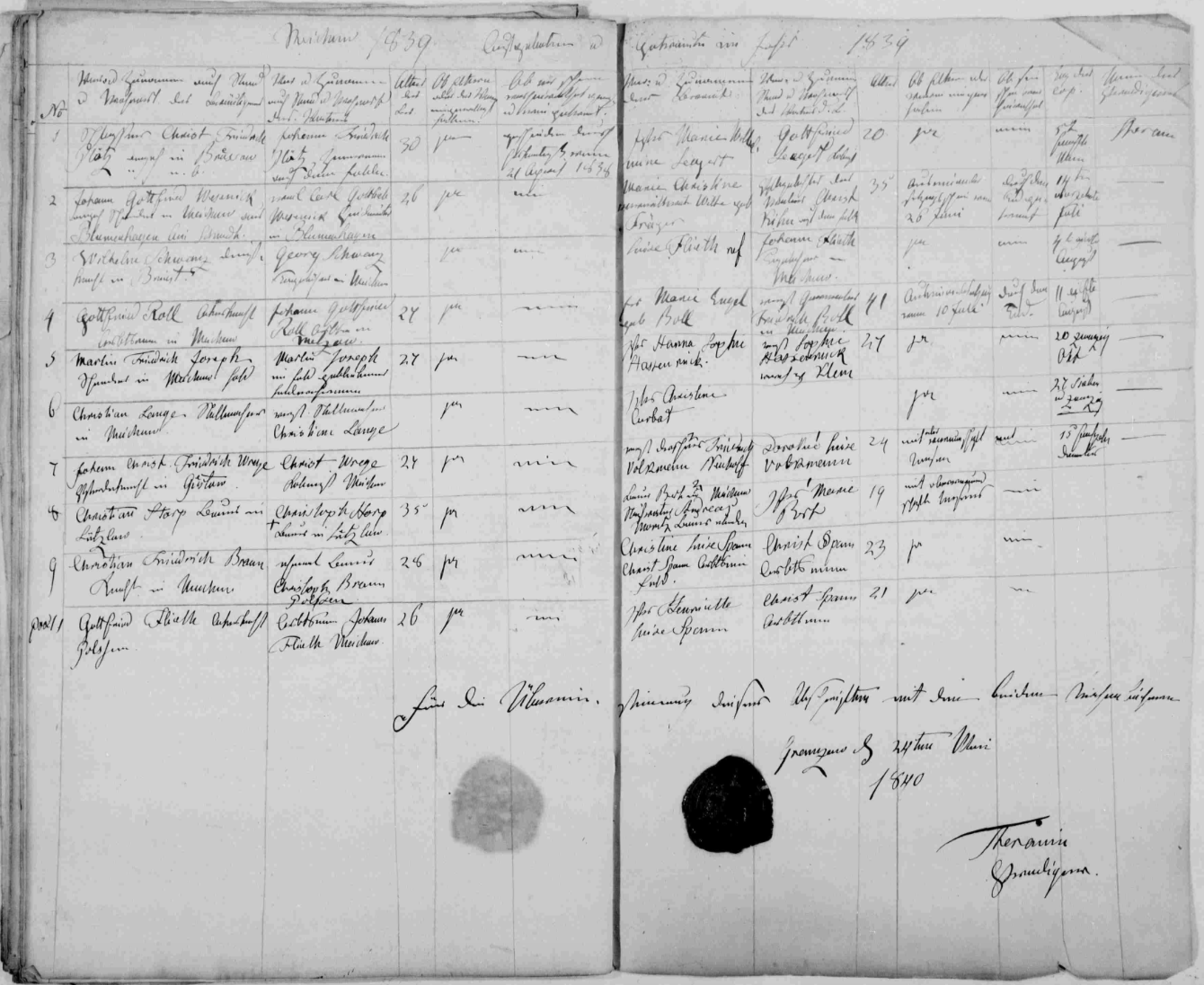


If we look closely we can see a 23 year old Christine Louise Spann and father Christ. Spann (Louise Henriette’s sister?), mentioned by chance in row 9, who married a Christian Friedrich Braun.
Children of Gottfried Flieth and Henriette Louise Spann
Gottfried and Louise Henriette had eight children while living in Meichow. All but two died very young, a few only survived a few days. Louise Wilhelmine was the fourth child and outlived all her siblings.
- Marie Louise Flieth (1840-1916), married Johann Hermann Kläckers (1827 – 1901)
- Carl Friedriech Flieth (31st December 1842 – 17th January 1843)
- August Friedrich Flieth (6th January 1844 – 25th January 1844)
- **Louise Wilhelmine Flieth (26th July 1845-1928), married **Johann Micheal Clur
- Carl Peter Flieth (1st august 1848 – 20th August 1848)
- Gottfried Flieth (25th February 1850-27th February 1850)
- Christine Wilhelmine Flieth (27th March 1853 – 29th May 1853), one of a twin
- Wilhelmine Ernestine Flieth (27th March 1853 – 27th March 1853), one of a twin






On this photograph we can also see the birth and baptism notice of Gottfried’s cousin, Peter Friedrich Flieth, (number 6 above), who was the son of Johann Flieth (c1815 – ?), Gottried’s half brother, and Wilhelmine Meissner.

Emigration to South Africa
After the arrival of the German legionaries Sir George Grey tried to procure more immigrants. Despite the landing in East London of The Lady Kennaway, a ship carrying Irish girls, there was still a desperate shortage of adult females in the Eastern Cape. He hoped by encouraging the immigration of potential wives for the soldiers he could bring about more stability in the settlement. However all German emigrants were “to be of respectable character” and should “chiefly be persons who have been engaged in agricultural pursuits”. They needed to be “in good heath and free from all bodily or mental defects at the time of embarkation.” Initially the age of the immigrants was not to exceed 45 years and “widows, widowers, single women with illegitimate children, persons who had been inmates of any penal, reformatory, or pauper institution, or who had not been vaccinated or had smallpox, were rigidly excluded”. Husbands were not “allowed to immigrate if unaccompanied by wives”, nor wives, “if unaccompanied by husbands, unless the husband was already in British Kaffraria”. Single woman “had to be under the proper guardianship of relatives, mistresses, or some other protection.” Later, as it was thought that parents of 45-50 years of age were more likely to have grown-up daughters, the age limit was raised to 50, and even later to over 50 provided they brought with them at least three unmarried daughters between the ages of 13 and 25 years. (“Part III The German emigrants of 1858-9 and 1859-62″, in “For men must work’ by E.L.G. Schnell)
Germany at that time (1858) was not yet unified and was in a period of political economic and social flux. Liberalism and industrialisation were spreading. In Prussia however, nationalism was gaining strength. Despite the abolition of “serfdom” in the West, an attempt to end manorial autonomy in Prussia failed in 1850, and the squires continued to exercise their powers over the workers on their lands. Most of the South African German immigrants came from the Prussian provinces of Uckermarck and Pomerania. They were mostly agriculturalists and general labourers and usually did not own their own land. They found life hard and generally lived from hand to mouth. The average daily wage then was 8 Groschen (about 7d) for a man and 4 Groschen for a woman. (XV Departure and Arrival in “Part III The German emigrants of 1858-9 and 1859-62″, in “For men must work’ by E.L.G. Schnell)
It is not surprising then that the prospects of a new life in South Africa interested them. To leave they had to first inform their employer and get written permission from the authorities to leave the state. They were required to advertise in the daily paper of their intention to emigrate to prevent absconding from debt and to prevent young men just due for military service from leaving. Once completed they were issued with a certificate from Potsdam wherein they were granted release from their Prussian citizenship. They were not allowed to take any furniture with them and their baggage was limited to 20 cu. ft. Hamburg measure. A small deposit of 30s was required for the advertisement, certificate of permission to depart, the medical certificate and many other minor matters. Most travelled by horse-wagon to the railway station and caught a train that then took them to Hamburg. Agents of Messrs. Dieseldorff and Co. met them in Hamburg and gave practical advice, carefully examined the eligibility of the applicants and attended to the signing of the Contract. The contract bound them to migrate to British Kaffraria and to accept the obligations imposed on them by the regulations. The signee accepted liability for the passage money and promised to pay it back according to the terms laid down. Every passenger had to bring his own bed-linen, eating and washing utensils. (XV Departure and Arrival in “Part III The German emigrants of 1858-9 and 1859-62″, in “For men must work’ by E.L.G. Schnell)
Louise Wilhelmine travelled with her father, Gottfried Flieth, mother Louise Henriette Spann and sister, Marie Louise, to South Africa. Louise and her family sailed on the ‘Wilhelmsburg‘ ship. (http://www.safrika.org/Names/KaffrariaNames.html#Frankfurt and Appendix XVIII, pages 285-287, of “For men must work’ by E.L.G. Schnell)

A Christian and Gottfried Spann, each with two children, are also listed and could have been Louise Henriette’s younger brothers. The fact that they all ended up settling in Frankfort also suggests that they were family (see below).


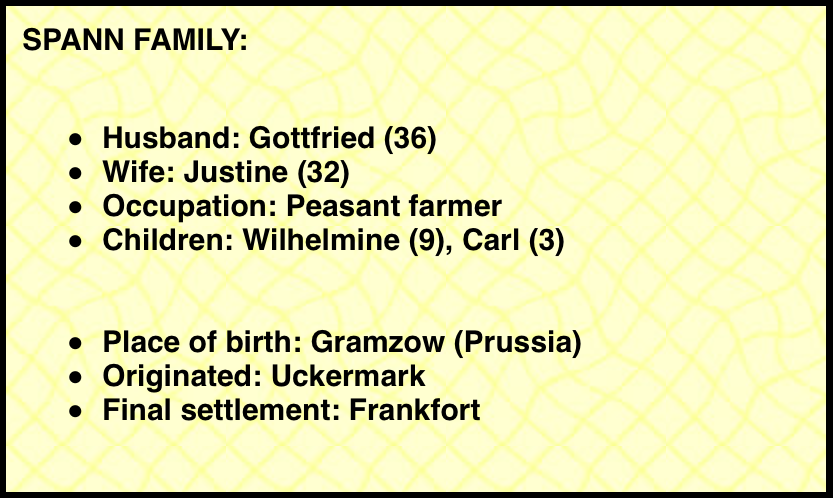
The ‘Wilhelmsburg‘ ship was captained by Captain C.H Muller. She was a sailing ship weighing 1000 tons and carried 563 people from 121 families, of whom 445 were adults. They departed from Hamburg, Germany on the 19th October 1858, and arrived on the 13th January 1859 at the West Beach, East London (or Panmure), South Africa. This ship was destained for disaster on its next voyage, sinking on the 16th April 1864 while taking other German settlers to Australia.

Other ships taking German settlers to South Africa at that time were the Caeser Godeffroy, La Rochelle, Wandrahm, Peter Godeffroy and Johann Caesar (or Cesar).The passengers were expected to behave while on board and every morning the lower decks had to be cleaned by the men after the beds had been made and everything was tidied up.
Every ship carried a doctor, and one a schoolmaster. The ship’s doctor of the Wilhemsburg was Dr Carl Paul (26), Weimar. The voyages were marked by many deaths especially of children. On the Caeser Godeffroy scarlet fever broke out causing the death of 18 children. On the Wilhelmsburg, 64 children and one woman died. (XV Departure and Arrival in “Part IIIThe German emigrants of 1858-9 and 1859-62”, in “For men must work’ by E.L.G. Schnell and http://www.eastlondon-labyrinth.com/germans/ship-wilhelmsburg.jsp)
Upon arrival in South Africa the settlers were initially accommodated in tents and then transported inland on wagons. Gottfried Flieth chose to settle in Frankfort near King William’s Town, South Africa, probably without any idea of the merits or lack thereof of the location. They apparently arrived there on the 14th January 1859 which was very quick in comparison with other settlers, some of whom waited up to a year for their land.
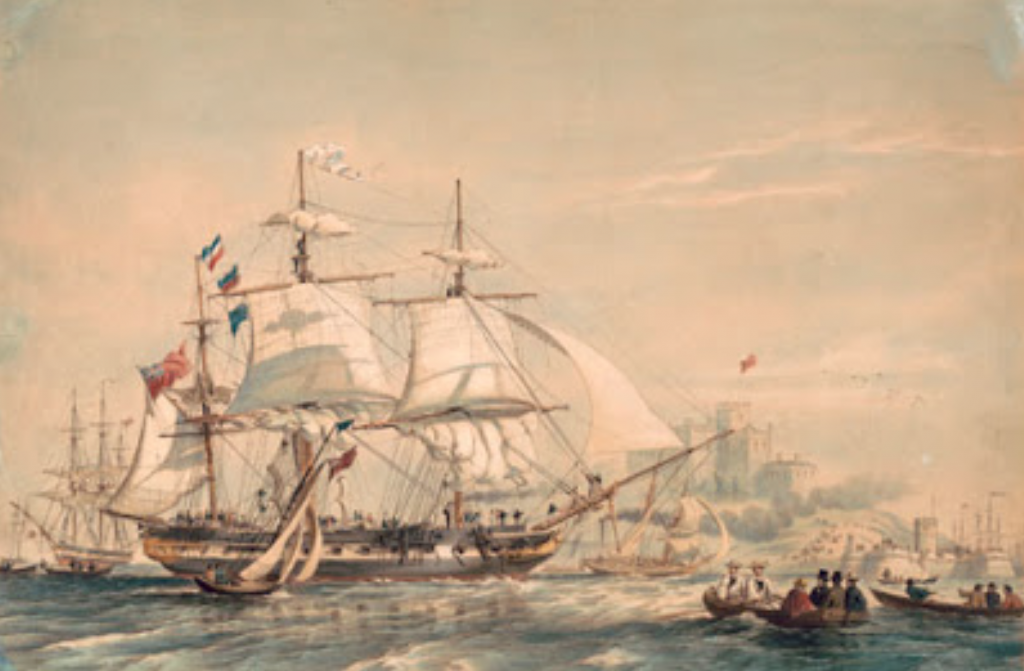


The arriving settlers were hospitably received by their fellow countrymen, Legionaries and the missionaries. Some were sheltered and given food by the Legionaries and later built their own houses “which had sod-walls under thatch without ceilings”. Some bought the at least 30 houses left vacant by the Legionaries that left to fight in India. They signed a bond with the Government for the price of the house based only on the actual amount disbursed for the erection of that particular house. The purchase price (varying between 6 and 20 pounds), had to be paid back in 5 annual instalments, starting in the 6th year. Seven houses in Frankfort were purchased by German immigrants.
The times that followed were hard and many of the babies and children died of pneumonia and other illnesses. The soil was not fertile and they had little in the way of seed and equipment to farm with. Above all they had no funds left. There were reports of sightings of starving emaciated girls in the streets after Government rations stopped in July 1859. Many men were forced to leave their land and families in search of work in the towns. Progress was slow at first, with mostly the woman and children turning the soil with a spade or hoe, referred to as the “German Blues”. Later the men returned and could buy ploughs. Those who could not afford draught animals pulled the ploughs themselves. In the first few years the seasons were favourable, the crops grew and were harvested. Later a slump followed and their produce fetched pitifully low prices. (XV Departure and Arrival in “Part III The German emigrants of 1858-9 and 1859-62″, in “For men must work’ by E.L.G. Schnell) (http://www.theheritageportal.co.za/article/german-relics-eastern-cape)
Pastors and teachers were lacking, the children were illiterate and spiritual life suffered as a consequence. Conditions did improve gradually as schools and churches were built. The Church and the home were focal points for social contact. The settlers kept their German culture and continued speaking German, they had established a “Little Germany”. My father told me that my Granny Louise Caroline Clur (Louise Wilhelmine’s daughter), still spoke German (first generation settler), and the Lutheran Church in the Ciskei was still conducting services in German in 1976. (http://www.theheritageportal.co.za/article/german-relics-eastern-cape)
Three words have been used to describe the German immigrants of that time; industrious, thrifty and honest. These qualities, plus legendary energy, gave them the strength to survive the difficulties they faced. They found contentment with the freedom they felt in South Africa, and in many cases they also found happiness. (XV Departure and Arrival in “Part IIIThe German emigrants of 1858-9 and 1859-62”, in “For men must work’ by E.L.G. Schnell)
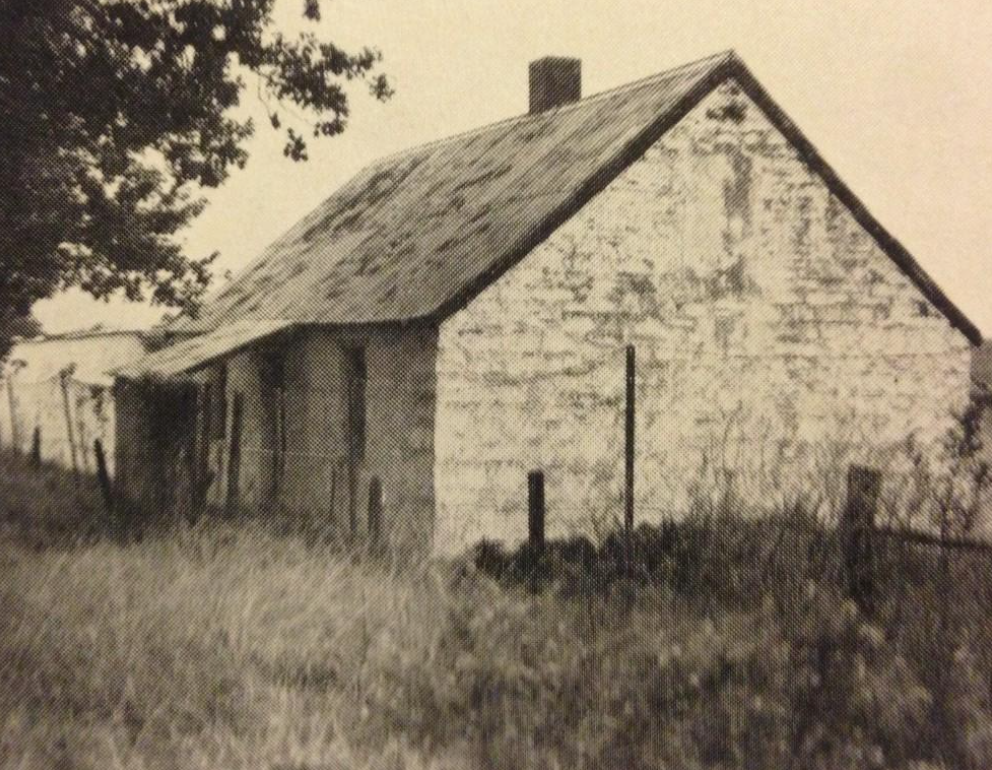
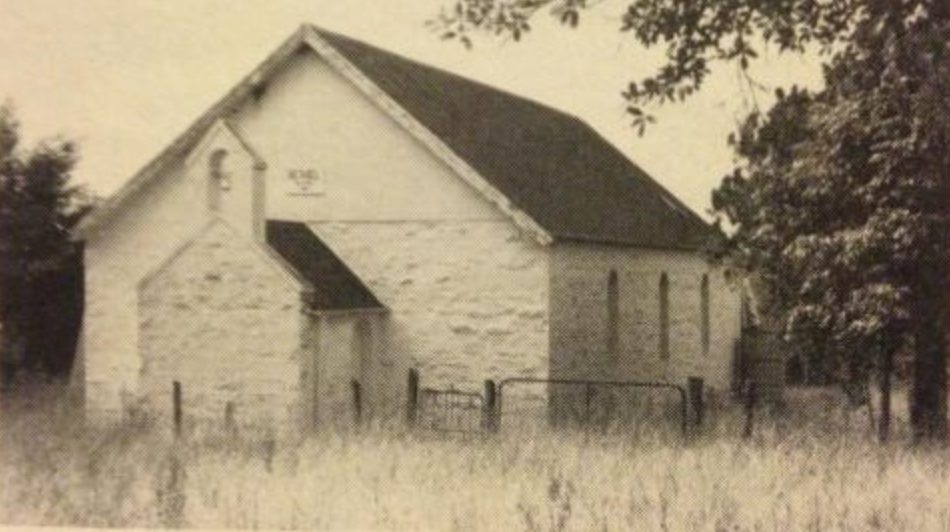

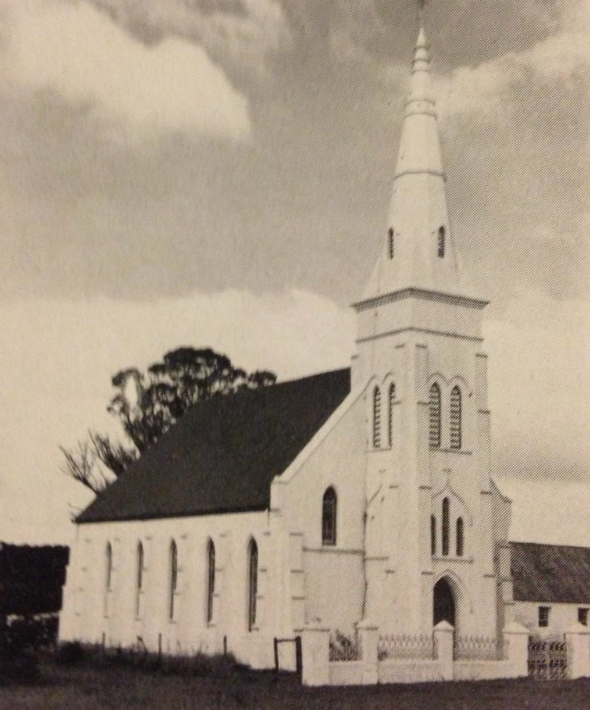
http://www.theheritageportal.co.za/files/lutheran-church-braunschweig-restorica-2-august-1976jpg
Gottfried Flieth died on the 1st July 1889, 30 years after landing in South Africa, at his grandson’s, my great-grandfather **Carl Friedrich Clur‘s residence in Frankfort near King William’s Town, South Africa. I see that my great-great-grandfather **Johann Michael Clur signed the certificate. His two surviving major children are listed: Louise Wilhelmine Clur nee Flieth and Marie Louise Kläckers nee Flieth. (Deceased Estate file No. 55/1890 (Cape Town) (Western Cape Archives).

